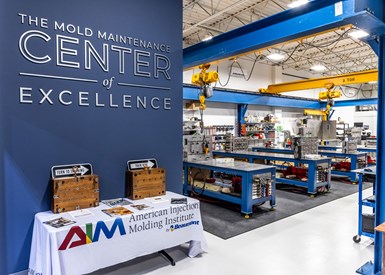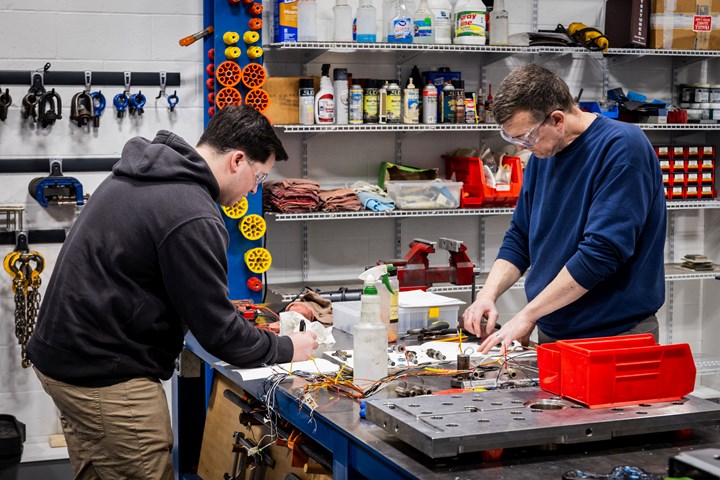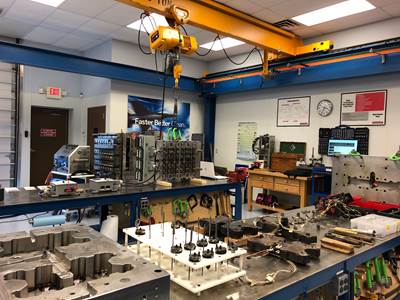
The Mold Maintenance Center of Excellence carries on the legacy that former owner Steve Johnson created with his hands-on and lecture mold maintenance workshop. It took about six months of planning and hard work to bring the vision to reality in January 2024. Source, all images: Beaumont Technologies Inc.
One of MMT’s more popular topics is mold maintenance and repair -- a critical aspect of moldmaking that impacts the OEM, molder and mold builder. A few years ago, I took a multi-day hands-on mold maintenance workshop in Ashland, Ohio, offered by MoldTrax at the time.
I shared my experience and takeaways in an article, which we are republishing in MMT as per reader feedback. Since attending that workshop in 2019, there have been some changes in ownership and instruction of the program, but the incredible value remains.
To get you up to speed, here is a Q&A with the current leadership of the workshop that recently held its first mold maintenance course in the new facility:
How has the addition of Mold Maintenance Courses to Beaumont Technologies’ AIM Institute impacted the comprehensive offering of courses since the summer when Steve Johnson passed on the legacy of these courses?
David Hoffman, Director, Instructor, Plastics Education & Training, American Injection Molding (AIM) Institute: We see the mold maintenance courses as a natural fit to our existing offerings. We were excited and honored that Steve reached out to us, and it was an easy decision from there. These courses give us the ability to offer the industry a full-service solution for nearly all educational aspects of the injection molding industry.
Since acquiring the assets of MoldTrax, we have been working on updating

Students enjoy the hands-on work where they tear molds apart, measure components, weld grind and reassemble molds. They especially like that the classroom interaction takes place inside of the maintenance bench area.
the courses to provide new content and synergy with our current courses. This will help ensure we are all teaching the same principles so there is no confusion as students naturally go from one course to another throughout their careers. When we were announcing the mold maintenance courses to students who were coming here for other courses, there was immediate interest. In fact, one student walked out of the room and called his boss immediately and said that they needed to be sending people to these courses. This person has since registered for the Hot Runner Troubleshooting & Repair course an is planning to attend others as well.
We are already seeing the cross-pollination of students in our existing courses going into the maintenance courses and vice versa. Just today, I was speaking with one of the mold maintenance students who expressed interest in coming to our Accredited Plastics Technology & Engineering Program (PTE Program).
And the demand already has been incredible. We had courses sold out in mid-January that were scheduled through June. In fact, we just added two more Hot Runner Troubleshooting & Repair courses due to the demand. And for the students who complete all five courses, they will receive an “Excellence in Mold Maintenance” certificate and polo.

Students tear down molds and reassemble them on benches with proper tools to provide a real-world experience.
What are the initial impressions and feedback from participants attending the Mold Maintenance Courses at the new facility in Erie, PA?
Glenn Keith, Instructor, Mold Maintenance for AIM Institute: The students enjoyed the first course and were impressed by the facility. Everyone liked the hands-on portions where they tore molds apart, measured components, welded, ground and reassembled the molds. There was a lot of classroom interaction too. Here are a few quotes from their evaluations:
- “I think the tooling industry should provide this course to all employees.”
- “Great course and good company trying to improve training and knowledge in a lacking industry.”
- “Great, Intelligent, clean and professional.”
- “Got more in-depth understanding of molds other than ‘Fix it.’”
- “I always wanted to try welding and this class made it happen.”
- “The hands-on breaking down of the mold and tig welding were my favorite parts.”
What are the plans for future courses and facilities for moldmakers and repair shop managers?
David Hoffman: We had the vision for The Mold Maintenance Center of Excellence almost immediately upon acquiring the assets. We wanted to carry on the legacy that former owner Steve Johnson created. This did not happen overnight. It took about six months of planning and hard work to bring the vision to reality.
Prior to the new facility, we held classes in original Ashland, Ohio facility. We

Students learn how to TIG and laser weld. They choose a stock mold component, which gets damaged and then either tig or laser weld the damaged area.
officially launched the Mold Maintenance Center of Excellence in Erie, PA, on January 23, 2024, with the Mold Maintenance, Troubleshooting & Repair course. Now we hold courses every month and are already seeing a high demand.
In some of our other development courses, we traditionally had students tear down molds and reassemble them, but that was taking place on small mold tables outside of our molding lab. But now since we have the Mold Maintenance Center of Excellence, the students use the maintenance benches and tools in the Center to provide a more real-world experience.
Due to the synergy of these courses, we are also looking to incorporate some aspects into a few of our existing program offerings. For example, we are heavily involved in a state-registered 2-year Plastics Process Technician Apprenticeship program. This program already includes a maintenance course, but it focuses solely on hydraulics and electrical systems. However, students in that apprenticeship program are working on molds, so we think it would be a good improvement to the curriculum to add some aspects of these newly acquired mold maintenance courses.
Also, we already approached the state about developing a new apprenticeship program focused on mold maintenance. We are also finalizing plans with a PA University to offer a 2-year Associate of Applied Science degree with a focus on Plastics Injection Molding. And, we are looking at opportunities to offer one or more of these classes as part of that curriculum as well. Finally, we are considering accreditation under the same ANSI/ASTM E-2659-18 standard that our PTE and Molders Series courses are accredited to.
We are planning an Open House for April 22, 2024.
We already approached the state to replace a few days of the current maintenance course with a 2–3-day course on mold maintenance, add a specific course on mold maintenance to the existing curriculum and develop a new apprenticeship program focused on mold maintenance.
Can you provide details on the five available courses and their relevance to industry needs, highlighting the hands-on learning experience and the comprehensive training approach for moldmaking personnel?
Glenn Keith: Mold Maintenance Troubleshooting & Repair Course (4 days)
This course provides a structured approach to maintenance vs. the typical freelancing often done in repair shops. We discuss the need for using standard terms and organized data collection that will be useful to their day-to-day operations.
For hands-on, we follow the procedure learned in the classroom to completely tear down a 16-32 cavity three-plate mold. From there, students identify and name each specific plate in the mold and conduct a full mold assessment, looking at each component and sharing their opinion on whether the mold is ready to run.
Components include vents, gates, leader pins, bushings. Some students struggle with measuring mold components as they have used measuring tools yet, so we teach the correct technique for each tool. Then, we damage a piece of tooling to replicate mold damage that they must fix by welding, grinding and polishing.
They TIG weld for an afternoon as they practice laying down beads on flats and edges. When they feel confident in their weld, they weld the damaged mold component. Everyone enjoys this portion.
On the last day of class, they finish their assessment, grind the weld and assemble the mold. Some students have never touched a surface grinder, so they really enjoy this portion of the program. Finally, they water-test the molds to verify that there are no leaks.

Workshop participants come with a mix of experience – some have never touched a hot runner system and others are very experienced, looking for either validation on the way they work on hot runners or new ideas to work more efficiently.
Hot Runner Troubleshooting & Repair Course (4 days)
We get students with a mix of experience. Some have never touched a hot runner system and others are very experienced, looking for either validation on the way they work on hot runners or new ideas to work more efficiently.
We match them up with a mold based on their experience level – ranging froma four-cavity Husky fixed-gate to a 48-cavity 55-zone Dynisco valve-gate system.
Students completely tear down the hot half of a mold with a few tooling issues (such a plastic leak, electrical problem or both). Before teardown, they use an Ohm Meter to check and record all heater and thermocouple resistance. During teardown, they look for clues on what could be causing the leak or electrical issue. We push them to measure, measure, measure! We want them to be able to use the measurements to either explain why the mold is having the issue or use the measurements as a reference to ensure the assembly is correct.
After teardown, they clean the plates and components with an ultrasonic cleaner or by hand, depending on the component. From there, they troubleshoot the issues and develop a repair solution, such as replacing heaters, thermocouples or manifold components. Finally, they assemble the molds, install valve pins (if needed) and verify that all the heaters and thermocouples are functioning by plugging the hot runner into a smart controller.

Students learn how to bench, stone, paper and polish a welded piece.
Mold Component Welding, Polishing & Repair (2 days)
This course starts with a brief time in the classroom then moves to all hands-on work. On the first day, students learn how to TIG and laser weld. They choose a stock mold component, which we damage and they either tig or laser weld the damaged area.
On the second day they learn how to bench, stone, paper and polish their welded piece. First, we give them a piece of tool steel and teach them how to go from a raw or ground finish to an A2 to A3 finish and they practice. They use their polished plate in the following Mold Texture & Repair Course.
Mold Texture & Repair Course (2 days)
After a brief instruction period, each student textures several patterns on their polished plate. We lead them through the acid etch texture and spray on texture process as well as explain EDM.
On the second day we damage their textured surface and they repair it via welding (tig or laser). Then they bench down the weld and repair the textured area by matching up the pattern with wax patterns and acid, free handing with a wax pen and tapping the pattern back in with a punch and hammer.

The AIM Institute is looking to add a 2- to 3-day course on mold maintenance to the PA State Registered Plastics Process Technician Apprenticeship program and develop a new apprenticeship program focused on mold maintenance. An open house is planned for April 22, 2024.
Mold Maintenance Strategies Course (3-day course)
This course is spent primarily in the classroom, learning what we consider to be the “one best way” to run a mold maintenance shop efficiently. We go over the (5) areas that influence efficiency, which are as follows:
- Leadership: Identify who is driving the bus and what they must bring to the table.
- Maintenance Strategies: Share different strategies and recommendations. We find that most companies practice reactive maintenance and firefighting.
- Documentation: Review what data must be collected and reported. This is the glue that holds everything together.
- Shop Layout: Go over the proper shop layout via our workshop, which is designed for molds up to 6000 pounds. We review what equipment is needed and why.
- Shop Skills: List the tasks technicians need to perform and the ways to teach the proper.
Related Content
Laser Welding Versus Micro Welding
The latest battle in finely detailed restoration/repair of mold materials.
Read MoreMold Innovations Power Unique Auto Lighting Elements on Hummer EVs
Diamond machining, electroforming of micro-optical inserts and modified latch-lock system help injection molds produce unique forward lighting elements.
Read MoreUltra-Fast Femtosecond Laser Texturing Helps Produce EV Lighting Lens Molds
Edge-lighting lens patterns present moldmaking challenges that ultra-fast femtosecond laser texturing technology can overcome.
Read More4 Keys to a Successful Mold-Building Operation, The Latest Mold Design Tips & More
MoldMaking Technology is off to a strong start this year with mold design tips, key considerations for running a mold-building “business,” polishing pointers for ribs and more. Check out our list of top-viewed articles from January and see what catches your eye.
Read MoreRead Next
Getting Hot and Heavy during a Little Hot Runner Training
If a mold is the heart of a molding system, then the hot runner system is the heart of a hot runner mold, and I recently learned that there is a lot to know when it comes to designing and maintaining these systems to ensure optimal mold and part quality and performance.
Read MoreWhat You Need to Know About Hot Runner Systems and How to Optimize Their Performance
How to make the most out of the hot runner design, function and performance.
Read MoreHands-on Workshop Teaches Mold Maintenance Process
Intensive workshop teaches the process of mold maintenance to help put an end to the firefighting culture of many toolrooms.
Read More























